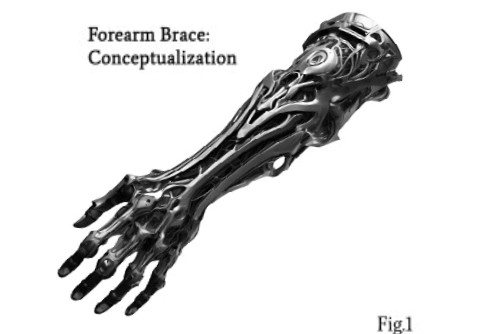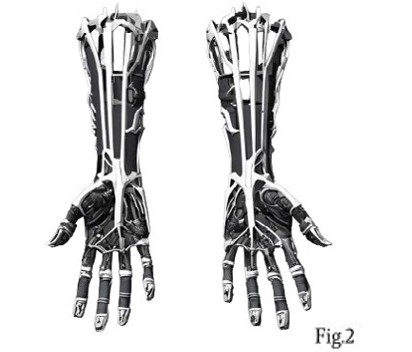Research Article - (2025) Volume 3, Issue 2
Surface-Level Human Advancements Exploring the Frontiers of Human Progress and Innovation
Received Date: Jan 08, 2025 / Accepted Date: Feb 05, 2025 / Published Date: Feb 13, 2025
Copyright: ©2025 Levi Bulger. This is an open-access article distributed under the terms of the Creative Commons Attribution License, which permits unrestricted use, distribution, and reproduction in any medium, provided the original author and source are credited.
Citation: Bulger, L. (2025). Surface-Level Human Advancements Exploring the Frontiers of Human Progress and Innovation. Eng OA, 3(2), 01-03.
Abstract
Surface-level human advancements, defined as the integration of technology with the human body to enhance physical capabilities (and, thus, in reference to mechanical systems designed to be worn on the body), represent a promising frontier in science and engineering. This paper explores the historical, cultural, and ethical dimensions of human enhancement, focusing on a novel concept that unites technology with artistic expression. By designing an ergonomic brace system equipped with lightweight materials and pneumatic muscles, this approach improves mobility and strength while maintaining aesthetic appeal. Technical insights delve into the choice of materials, including the use of lightweight alloys and advanced polymers for durability and flexibility. The proposed system leverages state-of-the-art pneumatic technologies to augment reflexes and physical support, with applications spanning rehabilitation and daily activities. By harmonizing functionality with artistic design, these advancements aim to inspire a modern reform in human enhancement, fostering a future where technology serves both practical needs and creative aspirations.
Introduction
Human advancement is not a novel concept. For centuries, scientists and storytellers have explored it in their works, captivating imaginations and fueling discourse. But what does "human advancement" mean for the average individual? More importantly, how does it shape our lives? This paper seeks to address these questions, presenting an exploration of progress, technological innovation, and the human race’s future with mechanical augmentation.
Defining Surface-Level Advancements
Surface-level human advancement refers to the integration of technology with the human body. Specifically, it involves combining advanced mechanics and scientific innovation (such as computer-assisted movement or the integration of AI within a system) with physical elements of the human form to enhance mobility, functionality, or structural support. When executed with precision and ethical consideration, this concept has the potential to revolutionize health, interaction, and overall human development.
Historical and Cultural Context
The idea of augmenting the human body dates back to ancient civilizations, where basic tools were developed for functional purposes. Developing innovative strategies to operate had direct effects on systems of irrigation, architecture, and civilization. The modern fascination with human enhancement, however, grew out of the technological revolutions of the 20th and 21st centuries, driven by breakthroughs in robotics, biotechnology, and materials science. Early representations in popular media, such as science fiction films and novels, presented a vision of human augmentation as both a utopian and dystopian future, where the boundaries between human and machine were blurred. This cultural portrayal has influenced both public perception and the direction of scientific research, framing human enhancement as both a promise of greater physical potential and a source of ethical debate. In the realm of art, augmentation has been explored not just as a tool for improvement, but as a medium for expression, where technology and aesthetics converge to create a new form of human identity. From the first introductions of steampunk aesthetics to the bioart movements of today, the cultural impact of merging technology with the human body has been profound, influencing everything from design philosophies to societal expectations of human performance.
Going further, the merging of machine and man has sparked considerable controversy, not only in public discourse but also within the scientific community. Ongoing debates among students, professors, and researchers continue to question whether such profound advancements could pose risks to privacy and security, particularly as the field of artificial intelligence grows ever more pervasive. As AI continues to evolve, concerns about the potential dangers of this technology often outweigh its perceived benefits, leaving many to wonder whether the pursuit of human enhancement could ultimately lead to unforeseen consequences. These debates remain dynamic, with perspectives shifting as new developments arise, further complicating the ethical landscape of human augmentation.

Real-World Applications
Surface-level human enhancements are not confined to the realm of fiction. In the real world, organizations and think tanks have extensively explored the ethical implications and practical possibilities of physical augmentation. For instance, the work of Julian Savulescu and Nick Bostrom, as documented in Human Enhancement, delves into the moral and societal aspects of these innovations. Meanwhile, companies like Ekso Bionics are pioneering real-world solutions. Since its inception in 2005, Ekso Bionics has developed exoskeletal systems, such as the EksoNR, to aid rehabilitation patients by improving mobility and strength. These advancements illustrate the tangible impact of human enhancement technologies on everyday life.
A New Concept: Blending Art and Technology
This paper introduces a novel concept that expands on existing ideas of surface-level human advancement, emphasizing the intersection of technology and art. The proposed design focuses on creating an innovative system that enhances the user’s physical capabilities while celebrating aesthetic expression. The objective is to inspire a movement where art and technology are not just intertwined but seamlessly unified.
The proposed system, more akin to a brace than a traditional exoskeleton, combines lightweight, high-quality materials with an artistic, ergonomic design. Integrated pneumatic muscles provide users with enhanced reflexes and strength, activated through sensors that detect and assist muscle movements. While the design does not delve deeply into manufacturing specifics, it embodies the vision of an artistic approach to human augmentation.
Technical Overview: Materials and Fabrication
The core of the proposed system is its pneumatic muscle technology, a sophisticated mechanism designed for efficiency, durability, and user comfort.
Materials Used
Elastomeric Polymers
• Material: Silicone rubber or thermoplastic elastomers (TPEs).
• Rationale: Provides high elasticity, durability, and flexibility, crucial for mimicking muscle-like contractions. Silicone is resistant to fatigue and wear, making it ideal for repetitive motion.
Reinforcement Layers
• Material: High-strength synthetic fibers such as Kevlar or Dyneema.
• Rationale: These materials offer exceptional tensile strength to withstand internal pressures generated by pneumatic inflation without excessive bulk or weight.
Structural Frame
• Material: Lightweight metals like aluminum or titanium alloy, combined with carbon fiber composites.
• Rationale: Ensures the system remains lightweight yet sturdy, enabling prolonged use without causing fatigue or discomfort. 4.4 Actuation System
• Components: Microvalves and pressure regulators made from corrosion-resistant stainless steel or durable polymers.
• Rationale: Ensures precision and reliability in controlling the pneumatic muscles, essential for seamless operation
Basic Fabrication Process
Muscle Construction
• Extrude elastomeric polymers into tubular shapes.
• Wrap the tubes with a helical pattern of reinforcement fibers to control expansion direction and enhance strength.
• Seal the ends with high-strength adhesive or vulcanization techniques to ensure airtight integrity.
Frame Assembly
• CNC machine the structural components to precise specifications.
• Use adhesive bonding and mechanical fasteners to integrate the pneumatic muscles with the structural frame.
Sensor Integration
• Embed piezoelectric sensors along the muscles to detect user movements.
• Connect sensors to a microcontroller for real-time processing and actuation.
• Apply artistic finishes using techniques like anodization for metallic parts and custom dyeing for polymer components.
• Collaborate with artists to create visually appealing patterns and forms that resonate with individual users.
Functionality and Impact
• Enhanced Mobility: Pneumatic muscles mimic the natural motion of human muscles, allowing for smoother, more intuitive movement. This is particularly beneficial for individuals recovering from injuries or those with mobility impairments.
• Improved Strength: By amplifying muscle output, the system reduces strain on the user's body, enabling them to perform tasks they otherwise could not.
• Artistic Expression: The system's customizable design allows users to express their individuality, breaking the stigma often associated with assistive devices.
• Psychosocial Benefits: Enhanced functionality combined with aesthetic appeal can boost user confidence and societal acceptance.
A Vision for the Future
Critics may view such concepts as futuristic or impractical. However, as society moves deeper into the digital age, the importance of meaningful art in daily life becomes increasingly vital. Just as the Renaissance revitalized creativity and innovation in the ancient world, surface-level advancements with artistic integration could spark a modern reform. In an era where rapid urbanization often prioritizes functionality over character, the incorporation of art into technological design serves as a reminder of humanity’s creative spirit
By normalizing human enhancements that blend technology with artistic expression, we can foster not only practical innovation but also inspiration for future creations. This vision transcends utilitarianism, advocating for a world where technology enriches lives while preserving and promoting artistic heritage.

Conclusion
Surface-Level human advancements offer an exciting opportunity for scientists, engineers, and artists to collaborate in shaping the future. These innovations can improve daily life while serving as an incentive for inspiration in an increasingly mechanized world. By merging technology with artistry, we can ensure that human progress is not only functional but also profoundly meaningful, keeping the spirit of creativity alive, and serving to inspire the next generation [1,2].
References
1. Bostrom, Nick, and Julian Savulescu. Human Enhancement. Oxford University Press.
2. Brenner, Lisa. “Exploring the Psychosocial Impact of Ekso Bionics Technology.” Archives of Physical Medicine and Rehabilitatio



